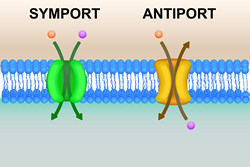Transport in the cell molecular machine
Recent discoveries about the antiporter system in cell membranes have sparked interest in exactly how different ions are transported in different directions at the same time. Recent data indicates that hydrogen and sodium ions are exchanged across the plasma membrane by an antiporter protein complex. The ITRANS (Ion transport at atomic level) project has used a new combination of experimental techniques to investigate a key molecular player in cell energy processes, the respiratory NADH: ubiquinone oxidoreductase (Complex I). Application of bioinformatics and molecular modelling has helped elucidate ion pathways and the functions of the different sections of the proteins involved. ITRANS researchers have designed a new method to study membrane proteins down to the atoms involved. Training was an integral part of the ITRANS project as well as collaboration between other scientific labs interested in areas involved in cell membrane transport. Ion transport is key to all cell functions and a greater understanding should help in unravelling the molecular details of highly complex mechanisms.







